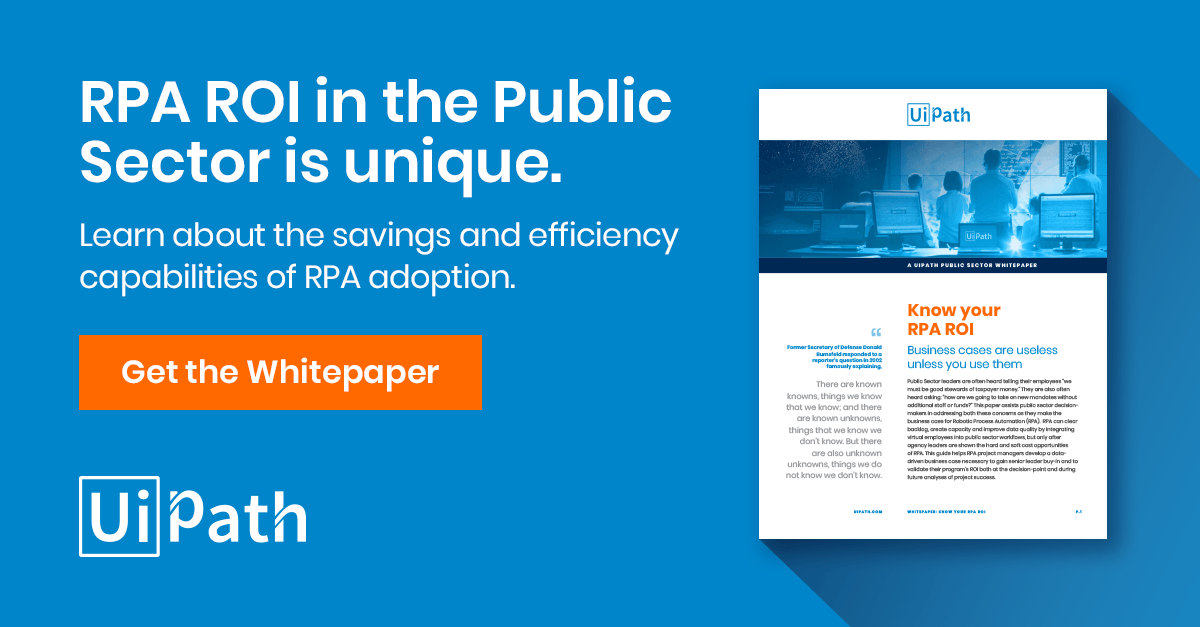Jim Walker, federal CTO for UiPath, said 25-to-30 agencies already are taking advantage of RPA to automate menial, repetitive tasks.
Overview of Robotic Process Automation
I would almost contend that we should declare 2018 as the year of the pilots. Agencies should be asked where is that $500,000 savings or where’s that $2 million savings if you can get if you automate that necessary work and free people up?
Jim Walker
Federal CTO, UiPath
It’s the wait attitude that seems to be lost opportunity now. Why not automate some simple processes to free people up to work on that data problem?
Jim Walker
Federal CTO, UiPath
Few technologies over the last 20 years have gotten as much attention and created as much early value as robotics process automation.
Agencies ranging from NASA to the General Services Administration to the Bureau of Fiscal Service to the Defense Logistics Agency have implemented bots and expect to save tens of millions of dollars.
And the excitement and thirst for this technology is being driven by the President’s Management Agenda’s goal of moving federal employees from low-value to high-value work. The Trump administration believes technologies like robotics process automation is part of the answer.
This is because agencies have found success using RPA to tackle repetitive, menial tasks, like copying and pasting text into forms.
Deloitte’s Center for Government Insights said in 2017 that RPA could save agencies as much as $41.1 billion over the next seven years.
But like with every technology there are challenges to overcome and potholes to avoid. Some estimate that as many as 50 percent of all RPA projects fail because organizations automate bad processes or because the bot is an add-on and not a long-term approach and/or because the RPA tool isn’t reviewed and improved to make sure it’s meeting the agency’s goals.
So how can agencies take advantage of this exciting new technology to save money, improve business processes and move employees to higher value work?
Jim Walker, federal CTO for UiPath, said robotics process automation is a software application that is trained to do the boring and repetitive tasks that employees currently are performing.
“If you are the Veterans Affairs Department and you have 900 people who do the same claims recovery every day, and you automate 50 percent of that activity for them, well that afternoon, if that’s working, you’ve doubled the capacity of the VA to work on those backlogged activities because they are now working in conjunction with that bot, or their personal intern if you will, doing those repetitive tasks that nobody is upset about not having to do,” Walker said on Carahsoft’s Innovation in Government show.
Moving employees off of those low-value, or as Walker likes to call it, necessary work and move them toward the high-value or more meaningful work. The Office of Management and Budget estimated in 2018 that five percent of all federal occupations could be automated entirely, while 60 percent of all occupations could have at least 30 percent of their work automated. Overall, OMB says 45 percent of all “total work activities” could be automated.
Walker said RPA is moving out of the “hype curve” because of what the administration is calling for– things like a new training effort for employees, a new policy for using RPA and the fact that 25-to-30 agencies are using this technology and starting to see savings.
“I would almost contend that we should declare 2018 as the year of the pilots. Agencies should be asked where is that $500,000 savings or where’s that $2 million savings you can get that you automate that necessary work and free people up?” he said. “The thing I like about the 25-to-30 agencies who have done something is they said they didn’t have to wait for perfection. If you are automating in your own network, the whole credentials outside your network is not nearly as critical. There still is a lot of automation that you can do just inside your building while you are waiting to figure out a better [security or governance] model.”
Walker said one big challenge with RPA is when agencies must share data to between systems because there are concerns about a bot reaching into their network. But there are ways to address this concern including providing details on the security and testing processes as well as understanding and mitigating any potential impact on the network if a bot is hitting a server thousands of times an hour.
One other common challenge is when organizations overlook the importance of including their chief information officer in the process.
Walker said the business area must be in charge of training the bot to do the finance or procurement work, but the CIO must play a big role in the ensuring the infrastructure and security that the bot relies on is in place.
“The agencies that are doing that are getting to the table, getting it served up and starting to have a robotics programs versus the ones who get started and then the process pulls them back,” he said.
Walker said another common reason why organizations hesitate to move to RPA is the data challenge. Many agencies must address “dirty” data and believe they can’t use bots until they have much better data.
But Walker said the bot can make all the data “from today” clean and then use another bot to “clean up” old data.
“It’s the wait attitude that seems to be lost opportunity now. Why not automate some simple processes to free people up to work on that data problem? Right now they are busy doing that necessary work on the data and not getting the data cleaned up,” he said. “If I have a process where I can automate all the emails that come so no person has to open an email, that will only take me a week or so to get it done and tested. Then, I can look at another part of my process that if I fix that, I will chip away at another 12 percent. I can do that in two or three or four week chunks instead of that traditional waterfall where we spend three months on a requirements document.”
Resource Center:

Copyright
© 2025 Federal News Network. All rights reserved. This website is not intended for users located within the European Economic Area.










